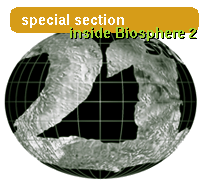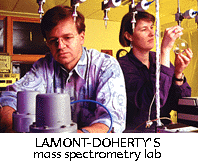

New challenges, new partnership: Lamont-Doherty and Biosphere 2
By JOHN C. MUTTER
IN 1949 LITTLE was known about the fundamental properties of the Earth and its oceans. Even simple data such as the depth of the ocean floor in many places were not known. Mid-ocean ridges were undiscovered, and a debate was brewing over the credibility of the proposition of continental drift. There were no computer models of the ocean's circulation, few observations of deep currents, and even fewer measurements of the ocean's chemical composition. Keeling had yet to begin his now-famous continuous measurements of CO2 concentration in the atmosphere from atop Mauna Loa.
 At that time, soon after the end of World War II, much knowledge about the oceans and
atmosphere was held by persons who had been in military service; they had studied the oceans
to understand acoustic energy propagation for submarine detection and the atmosphere to
understand missile trajectories. After the war many military-based scientists began to turn
their skills toward obtaining a more fundamental understanding of the nature of our planet.
They often returned to their university bases and rebuilt their relationships with geologists
and other traditional Earth scientists. In this way a unique new science began to emerge,
combining militarily acquired technical knowledge with more traditional academic inquiry to
create whole new disciplines.
At that time, soon after the end of World War II, much knowledge about the oceans and
atmosphere was held by persons who had been in military service; they had studied the oceans
to understand acoustic energy propagation for submarine detection and the atmosphere to
understand missile trajectories. After the war many military-based scientists began to turn
their skills toward obtaining a more fundamental understanding of the nature of our planet.
They often returned to their university bases and rebuilt their relationships with geologists
and other traditional Earth scientists. In this way a unique new science began to emerge,
combining militarily acquired technical knowledge with more traditional academic inquiry to
create whole new disciplines.
 1949 was also the year that one such grouping, which would become the Lamont-Doherty Earth Observatory, formed
out of the Department of Geological
Sciences at Columbia. A small group of scientists set up a research center in the mansion
on the 137-acre clifftop estate of the late Thomas Lamont. They were led by a single-minded
director, Maurice Ewing, who gave the institution a clear but broad mission: to gather
knowledge on every aspect of the world's oceans. So vast were the gaps in knowledge that the
mission required no more specificity than a commitment to excellence in all research
endeavors. Fueled by generous federal support under the Vannevar Bush paradigm,
scientists at Lamont made fundamental discoveries in almost all major fields of inquiry.
Paleomagneticists studied ancient magnetic fields to date events and track the motions of
continents. Seismologists studied elastic wave propagation to learn about the Earth's inner
structure and deformational processes. Geochemists and petrologists studied chemical
processes in the oceans, atmosphere, and the solid Earth. Geophysicists and geologists studied
the nature of the crust and upper mantle in and under the continents and oceans. If there was
a common theme to these studies, it was to observe carefully and broadly, and analyze well,
but always observe as the fundamental basis of the scientific method.
1949 was also the year that one such grouping, which would become the Lamont-Doherty Earth Observatory, formed
out of the Department of Geological
Sciences at Columbia. A small group of scientists set up a research center in the mansion
on the 137-acre clifftop estate of the late Thomas Lamont. They were led by a single-minded
director, Maurice Ewing, who gave the institution a clear but broad mission: to gather
knowledge on every aspect of the world's oceans. So vast were the gaps in knowledge that the
mission required no more specificity than a commitment to excellence in all research
endeavors. Fueled by generous federal support under the Vannevar Bush paradigm,
scientists at Lamont made fundamental discoveries in almost all major fields of inquiry.
Paleomagneticists studied ancient magnetic fields to date events and track the motions of
continents. Seismologists studied elastic wave propagation to learn about the Earth's inner
structure and deformational processes. Geochemists and petrologists studied chemical
processes in the oceans, atmosphere, and the solid Earth. Geophysicists and geologists studied
the nature of the crust and upper mantle in and under the continents and oceans. If there was
a common theme to these studies, it was to observe carefully and broadly, and analyze well,
but always observe as the fundamental basis of the scientific method.
One outstanding example is their contribution to the paradigm of global plate tectonics, which holds that the Earth's lithosphere is divided into quasi-rigid plates whose dynamic interactions cause seismic and tectonic activity at their boundaries. The initial breakthrough was the concept of seafloor spreading, developed by Vine and Matthews to account for the magnetic patterns observed to be associated with a mid-ocean ridges. As further elements of the theory unfolded in the 1960s, the vast archive of bathymetric, magnetic, gravity, seismic, and other data obtained by Lamont investigators aboard research vessels provided the key to establishing the theory's credibility.
 Today we are observers of a different type. There remain enormous basic unknowns in the
description of our planet, but as we approach the end of the millennium, attention is turning
in two directions. Our science is developing a new structure characterized by recognition that
the Earth is a large, complex, interactive dynamic system in which all the processes that give it
shape and form and that control its climate system are interdependent. Second, and perhaps
more profound, is the recognition that global-scale processes not only affect human activity
but are affected by it. The tenor of much Earth science research is shifting toward integrated
approaches based on global-scale, interdisciplinary studies that account for the observed
behavior of the whole Earth system, including biological phenomena and the linkages to
socioeconomic processes. We are beginning to ask new questions, such as: "Can we manage
the Earth to benefit humanity without causing its destabilization?"
Today we are observers of a different type. There remain enormous basic unknowns in the
description of our planet, but as we approach the end of the millennium, attention is turning
in two directions. Our science is developing a new structure characterized by recognition that
the Earth is a large, complex, interactive dynamic system in which all the processes that give it
shape and form and that control its climate system are interdependent. Second, and perhaps
more profound, is the recognition that global-scale processes not only affect human activity
but are affected by it. The tenor of much Earth science research is shifting toward integrated
approaches based on global-scale, interdisciplinary studies that account for the observed
behavior of the whole Earth system, including biological phenomena and the linkages to
socioeconomic processes. We are beginning to ask new questions, such as: "Can we manage
the Earth to benefit humanity without causing its destabilization?"
But how can we answer questions of this nature? The project we are embarking on at Biosphere 2 represents one potential approach. We seek answers about the nature of a future Earth where the concentration of CO2 is much greater than it is today. Just as humans benefit from enhanced oxygen, plants respond well to enhanced CO2. Most grow faster, taller, and broader, with larger leaves. But every plant seems to respond in a different way. Commercial crops critical to the economies of agricultural countries exhibit growth enhancement different from that of native plants that sustain subsistence farming in poorly developed countries. Desert plants and rain-forest plants behave differently. Biosphere 2 is being used for multi-species experiments in the controlled enclosure whose scale, though hardly comparable to a natural ecosystem, allows for the plausible extension to a true ecosystem.
Life everywhere is sustained by the plants we eat. What crops should we plant in the future? Ideally, we should plant crops that benefit most from the expected higher CO2 levels but do not require greatly enhanced nutrient or water supplies to support the growth. Decisions of this nature--true planetary management decisions--should be based on information provided by scientists to government and should not be applied until they have passed through stringent social and economic analyses. Most importantly, they must be based not on conjecture but on what is known and, better yet, what is understood. Our aim at Biosphere 2 is to provide the basis of understanding upon which such decisions might be made.
But these decisions will also require completely new scientific structures. Unlike the post-WW II regrouping, which was essentially intradisciplinary, this time there will need to be a true dialogue across fields of endeavor that seldom intersect. Plant physiologists will need to become research partners with economists, agronomists with social scientists, and engineers with public health workers. Herein lie new challenges and great opportunities.
PHOTO
CREDITS: J. B. Diedrich / ©1990 Lamont-Doherty Earth Observatory
(Ewing); John Faulkner / ©1994 Lamont-Doherty Earth Observatory (lab); David Dick (Lamont Hall).
JOHN C. MUTTER, Ph.D., is deputy director
of Lamont-Doherty Earth Observatory and vice president of Biosphere 2.




